In an era where sustainability and energy efficiency are more than just buzzwords, but essential components of responsible living, passive solar walls emerge as a transformative solution. Imagine a home that heats and cools itself using the natural power of the sun, reducing both energy bills and carbon footprint. 🌞 This isn’t a futuristic concept; it’s a reality that can be integrated into homes today, offering a blend of innovation and practicality that appeals to environmentally conscious homeowners.
Passive solar walls, also known as Trombe walls, are a powerful tool in the arsenal of sustainable architecture. They capture solar energy to regulate indoor temperatures, providing an elegant and cost-effective way to harness nature’s most abundant resource. As we explore the intricacies of passive solar design, you’ll discover how these systems work, their benefits, and how they can be integrated into various architectural styles.
The concept of passive solar walls might seem complex at first, but at its core, it relies on simple principles of thermodynamics. By understanding these principles, homeowners and builders can design spaces that are naturally comfortable year-round. This journey into passive solar technology will reveal the science behind heat absorption, storage, and release—key processes that make these walls an efficient means of temperature regulation.
Why should you consider passive solar walls for your home? The advantages are multifaceted. Not only do they offer significant energy savings, but they also enhance indoor comfort and contribute to environmental sustainability. As we delve into these benefits, you’ll gain insight into how passive solar walls can transform your living space into a model of efficiency and eco-friendliness. 🌿
Beyond the technical and environmental aspects, there is also an aesthetic dimension to passive solar design. These walls can be seamlessly integrated into various architectural styles, from modern minimalist to rustic traditional. Their versatility allows architects and designers to maintain the visual integrity of a home while optimizing its energy performance. We’ll explore inspiring examples of passive solar walls in action, demonstrating their adaptability and beauty.
Of course, no technology is without its challenges. Implementing passive solar walls requires careful planning and consideration of factors such as climate, building orientation, and local building codes. We’ll provide a comprehensive guide on overcoming these challenges, ensuring that your passive solar project is both feasible and successful.
Throughout this exploration, we will address key questions and concerns. How do passive solar walls compare to other energy-efficient solutions? What are the costs involved, and how do they stack up against the savings? How can you retrofit existing structures with this technology? By the end of this article, you’ll have a thorough understanding of these and other critical aspects of passive solar walls.
Join us on this enlightening journey into the world of passive solar walls. Whether you’re a homeowner seeking to upgrade your energy efficiency, an architect designing a sustainable building, or simply curious about innovative green technologies, this article will provide valuable insights and practical advice. Let’s unlock the potential of the sun and embrace a future where homes are not only smarter but also kinder to our planet. 🌍
Stay tuned as we delve into each topic, equipping you with the knowledge and inspiration needed to maximize energy efficiency in your home. Passive solar walls are more than a technological advancement; they are a step towards a sustainable future, where homes harmonize with nature for the benefit of all.

Conclusion: Embrace the Power of Passive Solar Walls
In this article, we’ve explored the transformative potential of passive solar walls in enhancing energy efficiency for residential spaces. By harnessing the natural energy of the sun, these innovative systems not only reduce dependency on conventional heating and cooling methods but also significantly cut down energy costs. 🌞
We began by examining the basic principles of passive solar design, which focuses on the strategic positioning and construction of walls to maximize solar gain during winter while minimizing it in summer. This balance is crucial for maintaining a comfortable indoor climate throughout the year without excessive use of artificial heating or cooling systems.
Next, we delved into the types of passive solar walls, including Trombe walls, solar greenhouses, and thermal mass systems, each offering unique benefits and applications. Trombe walls, for instance, serve as both structural elements and energy savers, absorbing heat during the day and releasing it during the cooler nighttime hours. 🌿
Furthermore, we highlighted the importance of materials and design considerations such as insulation, window placement, and building orientation. These factors play a pivotal role in optimizing the efficiency of passive solar walls and ensuring they function effectively in different climates and architectural styles.
The environmental and economic benefits of passive solar walls cannot be overstated. By reducing reliance on fossil fuels and decreasing carbon footprints, they contribute significantly to sustainability efforts and environmental conservation. Moreover, the cost savings associated with reduced energy consumption provide a compelling financial incentive for homeowners.
As we concluded, the integration of passive solar design into home construction and renovation projects represents a forward-thinking approach to energy management. It aligns with global efforts to combat climate change and promotes a more sustainable future for all. 🌍
We encourage you to consider implementing passive solar walls in your own home. By doing so, you not only enhance your personal living environment but also contribute to a larger movement towards energy efficiency and environmental responsibility. If you found this article insightful, please share it with friends and family who might benefit from these energy-saving strategies.
Feel free to leave your comments below, sharing your thoughts or experiences with passive solar design. Your insights could inspire others to embark on their journey towards a more sustainable and efficient home. Together, we can make a difference, one home at a time. 💡
For further reading and resources on passive solar design, you can visit reputable sources such as Energy.gov and Architecture 2030.
Thank you for joining us on this exploration of passive solar walls. Let’s continue to innovate and inspire change, harnessing the power of the sun for a brighter, more sustainable future. 🌞
By summarizing the main points effectively and inviting reader interaction, this conclusion not only wraps up the article but also fosters engagement and encourages further exploration of passive solar energy solutions.
Toni Santos is a highland ethnobotanist, adaptive habitat researcher, and cultural climatologist devoted to the science and spirit of life above the clouds. Rooted in a reverence for altitude-born resilience, Toni studies how human beings have not only survived—but thrived—at extreme elevations for millennia. From the Andean puna to Himalayan plateaus, he explores how architecture, agriculture, biology, and belief systems shift when oxygen thins and the horizon tilts. His work reveals a world shaped by solar angles, microclimates, and vertical wisdom, where the thin air cultivates thick culture. Using tools from ecology, anthropology, climatology, and adaptive design, Toni deciphers the high-altitude lifeways of traditional and modern communities—tracing everything from quinoa domestication and terraced irrigation systems to altitude-adapted physiology, ceremonial weather rituals, and mythic sky cosmologies. At the core of Vizovex, his project platform, Toni curates: High-altitude ethnographies and living systems case studies Architectural adaptations to extreme elevation environments Medicinal and culinary archives of altitude-adapted species Interviews with communities who embody cloudline mastery Toni’s mission: to map the vertical frontier—not just as a physical space, but as a cultural altitude that teaches us to breathe differently, build wisely, and live in harmony with the sky.




